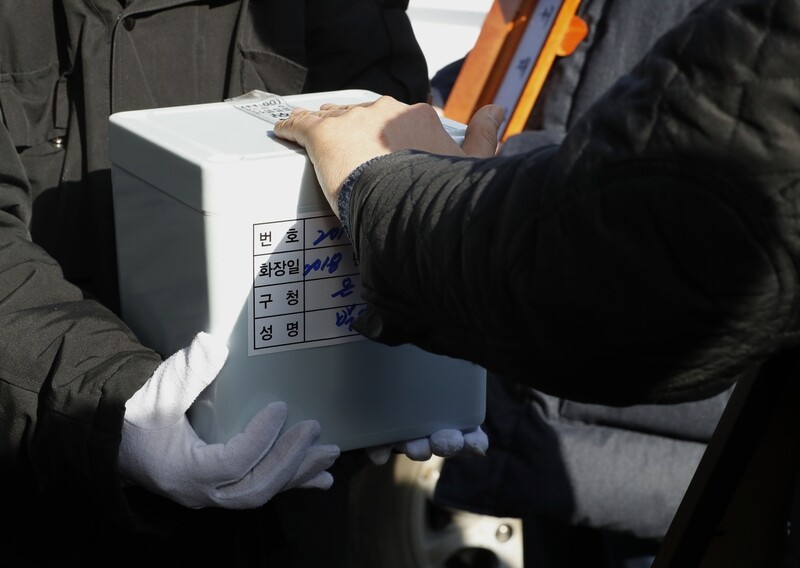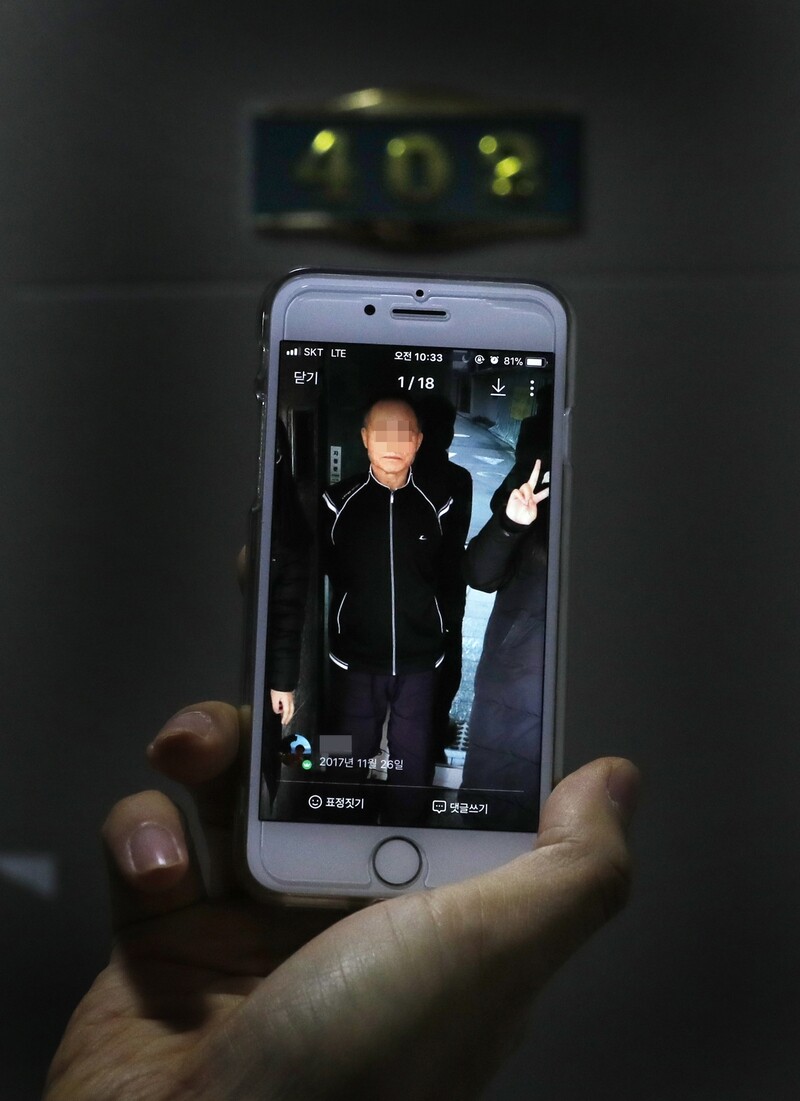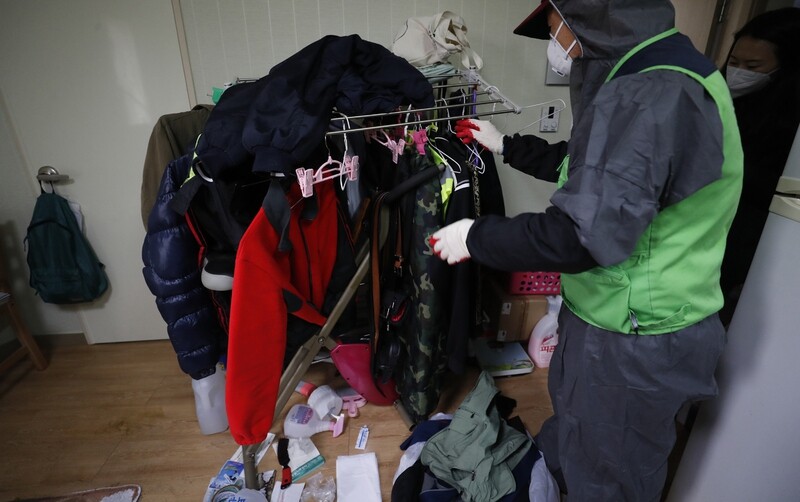hankyoreh
Links to other country sites 다른 나라 사이트 링크
Report documents instances of lonely deaths in South Korean society

The significance of life and death is determined by how one is remembered by friends and family. Some people live again in other people’s memories, while others disappear into oblivion. When people die alone, isolated from their families and from society, their death is remembered as an awful stench, and that too is soon forgotten. Deaths that are as lonely as the life that preceded them are closer than you might think. Just in the city of Seoul each year, there are at least 162 such deaths, called godoksa in Korean. Every two days, one of our neighbors ends a lonely life in a solitary death.
After obtaining a 2014 report on the current status of lonely deaths that was prepared at the behest of the National Assembly by Sweepers and HardWorks, two companies that specialize in cleaning up after godoksa, the Hankyoreh examined the report to see what kind of people are dying alone. The records, which are organized in an Excel file, show that the godoksa victims generally lived in low-quality accommodations, such as the cramped boarding houses known as gosiwon, without a housing deposit, and died of alcoholism and other chronic conditions. When the deceased was in their forties or below, the cause of death was typically suicide.
With “godoksa” still lacking a legal definition and governmental statistics on the subject hard to come by, a fact-finding study on godoksa in Seoul and ways to help at-risk groups published in Dec. 2016 by the Seoul Welfare Foundation is the only document that allows us to review the current state of godoksa at the metropolitan level. According to this study, there were 162 definite cases and 2,181 suspected cases of lonely deaths in Seoul in 2013. When the definite cases are combined with the suspected cases, the number of lonely deaths increases to 2,343. That represents 0.2% of the total 932,368 single-person households in Seoul in 2013.

■ Deaths that lack both definition and statistics
While the word lonely deaths often appears in the news and elsewhere, the concept has yet to receive a precise legal definition. In general usage, lonely deaths means a person who lives and dies alone and whose corpse is found after a considerable amount of time has passed. But this is only a makeshift definition accepted by academics and the media. The lack of a legal definition also makes it hard to find statistics or policies tailored to this issue.
Because of godoksa’s ambiguity, a workaround has been to substitute statistics for “unconnected deaths.” This refers to those who die without a next of kin, or without family members willing to accept the body, leaving the local government to handle the funeral arrangements and the disposal of the deceased individual’s effects. But since lonely death is another way of referring to being cut off from society, experts believe that the term needs to be distinguished from merely dying without connections.
Given these concerns, bills designed to deal with the lonely death phenomenon are currently pending at the National Assembly. This past October, Democratic Party lawmaker Gi Dong-min and Liberty Korea Party lawmaker Kim Seung-hui submitted separate bills aimed at preventing godoksa.
Another question is how long the body must be neglected before it is described as a case of lonely death. The Seoul Welfare Foundation offers one possible answer in its Seoul godoksa study: “The process of decomposition of the corpse after death can be divided into five stages (very mild, mild, moderate, severe, and very severe). It is normal for the body to be discovered and the family contacted within three days of death. After that, the face and other parts of the body began to become deformed. If ‘significant time’ is to be defined in connection with the process of changes in the body, lonely death could be defined as occurring when a body is discovered at least three days after death.”

■ Dying alone in a gosiwon without a housing deposit
It is difficult to find systematic records of the final disposition of godoksa bodies, of those who ended their life in isolation. Sweepers’ and HardWorks’s records of the property of the deceased in lonely death cases in 2014 serve as an invaluable source of information about their lives.
In a substantial number of the 41 cases of lonely deaths that appear in these records, the deceased ended their life in “residential poverty.” Six of these individuals died in a gosiwon without a housing deposit and one in an “officetel” apartment without a housing deposit. There were also two cases in which the deceased had a housing deposit that was completely used up to pay back rent. In five cases, it is unclear whether or not there was a housing deposit.
These bodies were typically found in a state of severe decomposition, reflecting the severity of their social isolation. While there are no external changes to the body for two days after death, after the third day, the abdomen starts to swell. Between 12 and 20 days after death, the body starts to collapse. Among the 41 individuals whose remains were collected by these companies, 31 had been in a “severe” state of decay or worse. The severe stage means that the external changes to the corpse have ended and it has begun to desiccate like a mummy.
“By the time that professional cleaning companies like us are contacted, decomposition has often advanced so far that the landlord or family members are no longer able to handle it. Landlords frequently report a lonely death when a tenant is behind on their rent and no longer responds to contact. In that case, the cleaners go in quietly around 1 or 2 in the morning to do their work so that no one knows about the death,” said Kim Wan, CEO of HardWorks and a member of Seoul’s godoksa task force.

■ Chronic diseases are the cause of death for those in their 50s and above, and suicide for those in their 40s and below
Many cases of lonely deaths are caused by chronic diseases such as alcoholism and diabetes. According to the report prepared by Sweepers and HardWorks, chronic diseases were the cause of death in 20 of the 41 cases. The most common condition, in six cases, was alcoholism, and alcoholism was combined with cirrhosis of the liver, diabetes and heart disease in one case each.
Suicide also accounted for a high percentage of the causes of death, with the deceased ending their life in 12 of the 41 cases. Nine of these 12 suicides were “young godoksa,” in other words people in their forties and below. Various causes of death were also reported in the Seoul godoksa study, including alcoholism, cirrhosis of the liver, diabetes and cerebral infarction. This suggests that people who live alone and are cut off from their social network while also suffering from a chronic condition are the at-risk group for lonely deaths. Since such individuals are likely to pay regular visits to medical institutions, some say that a lonely death management system should be created with them as the focus.
■ Care for ‘involuntary single-person households’ should begin with the neighbors
According to the Seoul godoksa study, which provided more details about the site of the death, 34.5% of the 162 definite godoksa cases occurred at low-rise apartments, 17.9% at rental apartments, 8.0% at gosiwon, 5.5% at low-rise apartments called “villas” and 5.5% in studio apartments. Some of these bodies were even found in places that were not proper homes, such as flophouses, warehouses and supermarket closets.
When the 162 definite cases of lonely deaths in Seoul are broken down by district, the largest number occurred in Gwanak District (19), followed by Nowon District (18), Guro District (17) and Gangseo District (13). If this is expanded to include the 2,181 suspected cases, Eunpyeong District had the most, with 151, ahead of Dongdaemun District (144), Gangnam District (143), Nowon District (130) and Gwanak District (129).
In short, many cases of lonely deaths are found in parts of the city where housing is more affordable. In Gangnam District, there was a high percentage of “young godoksa,” with people in their twenties and thirties. Many of these were presumably suicides by people who lived in officetels or studio apartments near their place of employment.
Most cases of lonely death are discovered by landlords who drop by when rent stops being paid or by neighbors who report the unbearable stench of a rotting body to the police.
“Management is needed for risk areas selected according to residential characteristics. There should be a government program to provide focused monitoring and support for the at-risk group who live in areas where godoksa is frequently discovered,” said Song In-ju, an analyst with the Seoul Welfare Foundation.
“Many of the people who suffer lonely deaths are ‘involuntary single-person households’ who were separated from family members by divorce or bereavement. The local community needs to take action to help people who are socially isolated restore their trust in other people and in institutions,” said Hong Yeong-jun, a professor of social welfare at Sangmyung University.
By Shin Ji-min and Jang Su-kyung, staff reporters
Please direct questions or comments to [english@hani.co.kr]

Editorial・opinion
![[Column] Park Geun-hye déjà vu in Yoon Suk-yeol [Column] Park Geun-hye déjà vu in Yoon Suk-yeol](https://flexible.img.hani.co.kr/flexible/normal/500/300/imgdb/original/2024/0424/651713945113788.jpg) [Column] Park Geun-hye déjà vu in Yoon Suk-yeol
[Column] Park Geun-hye déjà vu in Yoon Suk-yeol![[Editorial] New weight of N. Korea’s nuclear threats makes dialogue all the more urgent [Editorial] New weight of N. Korea’s nuclear threats makes dialogue all the more urgent](https://flexible.img.hani.co.kr/flexible/normal/500/300/imgdb/original/2024/0424/7317139454662664.jpg) [Editorial] New weight of N. Korea’s nuclear threats makes dialogue all the more urgent
[Editorial] New weight of N. Korea’s nuclear threats makes dialogue all the more urgent- [Guest essay] The real reason Korea’s new right wants to dub Rhee a founding father
- [Column] ‘Choson’: Is it time we start referring to N. Korea in its own terms?
- [Editorial] Japan’s rewriting of history with Korea has gone too far
- [Column] The president’s questionable capacity for dialogue
- [Column] Are chaebol firms just pizza pies for families to divvy up as they please?
- [Column] Has Korea, too, crossed the Rubicon on China?
- [Correspondent’s column] In Japan’s alliance with US, echoes of its past alliances with UK
- [Editorial] Does Yoon think the Korean public is wrong?
Most viewed articles
- 1‘We must say no’: Seoul defense chief on Korean, USFK involvement in hypothetical Taiwan crisis
- 2N. Korean delegation’s trip to Iran shows how Pyongyang is leveraging ties with Moscow
- 3[Column] Park Geun-hye déjà vu in Yoon Suk-yeol
- 4Amnesty notes ‘erosion’ of freedom of expression in Korea in annual human rights report
- 5‘Weddingflation’ breaks the bank for Korean couples-to-be
- 646% of cases of violence against women in Korea perpetrated by intimate partner, study finds
- 7[Reportage] On US campuses, student risk arrest as they call for divestment from Israel
- 8“Parental care contracts” increasingly common in South Korea
- 9[Interview] Dear Korean men, It’s OK to admit you’re not always strong
- 10Korean government’s compromise plan for medical reform swiftly rejected by doctors